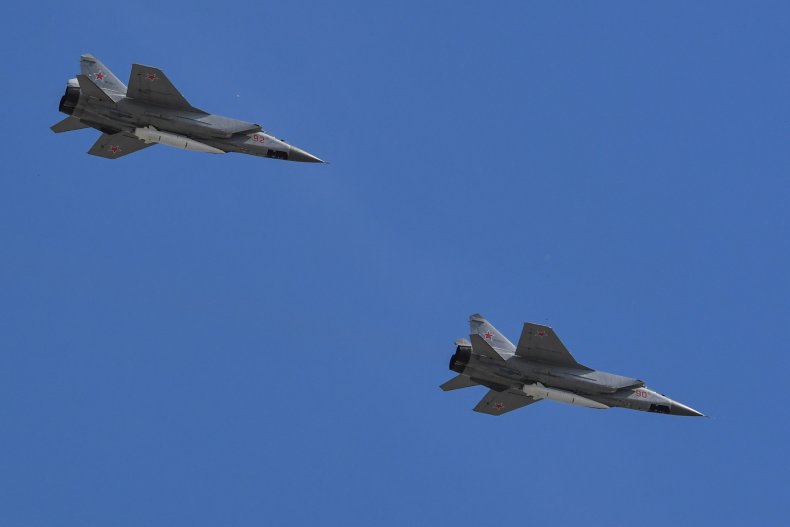DAVID BRENNAN
Arecent propaganda video released by the Chinese military has brought one of the country's most advanced and threatening technologies back to the fore—hypersonic weaponry.
Hypersonic weapons travel at incredible speed and—unlike even the most advanced ballistic missiles—can maneuver in flight. This gives the weapons enormous range and makes them much harder to track and stop.
The U.S., Russia and China are all investing heavily in hypersonic technologies. However, the Pentagon has been the slowest to jump on the bandwagon and military chiefs are warning that the U.S. could be left behind by its authoritarian adversaries, at least when it comes to nuclear-capable hypersonics.
The U.S. still maintains by far the most powerful military on Earth, supported by a military budget larger than that of the next seven biggest spending nations combined. As such, America's rivals must consider intelligent methods of leveling the playing field and—at least on a local or regional level—upending long-held U.S. military hegemony.
This is especially true for China, where the government has invested huge sums in bringing its outdated military up to scratch. Beijing is rapidly transitioning to a potent modern force, but one still inferior to the U.S.
Nonetheless, military spending has been geared towards exploiting U.S. weaknesses and dominating East Asia. Beijing is hoping that its hypersonic weapons will form a key element in this disruptive strategy.
There are two types of hypersonic weapon—cruise missiles (HCMs) and glide vehicles (HGVs). Both are able to travel at speeds of Mach 1 or higher—around 3,800 miles per hour—and can maneuver during flight. This makes them difficult to shoot down, but also means it is very difficult to predict what target they will hit.
HGVs are launched by a ballistic missile, but the hypersonic component itself does not have an engine. HCMs can be launched by other vehicles such as fighter jets or naval vessels, and power themselves with internal engines. Both weapons can be armed with either nuclear or conventional warheads.
China is working on both types of weapon. According to Douglas Barrie, a senior fellow for military aerospace at the International Institute for Strategic Studies, Beijing is within "a few years" of fielding an HGV.
China already fields a daunting missile arsenal, whether subsonic, supersonic or ballistic. For enemies, this already challenging scenario is exacerbated by the introduction of HGVs.
As Barrie told Newsweek, HGVs "fly at an altitude not presently well covered by radar systems, and given their speed also potentially cut down reaction and decision time on the part of the defender. Were [China] to go ahead and also field hypersonic cruise missiles then this defensive picture would become only more complex."
"Any system that reduces reaction and decision time is potentially further destabilising," Barrie added. China's interest in HGVs in part would seem to be driven by the desire to counter missile defence systems that are already or could be deployed in the Indo-Pacific theatre."
Hypersonic weapons will form a key element of Chinese military strategy. U.S. force projection depends on regional bases and aircraft carriers. As James Bosbotinis—the co-CEO of U.K.-based JB Associates and an expert in maritime and aerial security—explained, it is these "high-value" targets that hypersonic weapons will focus on, particularly where evading anti-missile defenses is required.
"Leadership facilities, key command and control centers, underground facilities, air bases, time-critical targets such as mobile missile launchers" and maritime targets will all be on the list, Bosbotinis told Newsweek.
Once deployed, the weapons will "significantly enhance" Chinese strike capabilities in East Asia, Bosbotinis continued. The DF-17 HGV (known by the Pentagon as WU-17), for example, has a reported range of between 1,118 and 1,553 miles. This system is expected to be operational by 2020, at which point it will be the world's first HGV put into service.
Though daunting, Bosbotinis noted that hypersonic weapons "are not a panacea nor invincible. Long-range precision strikes are dependent on a supporting 'kill chain' of intelligence, surveillance, and reconnaissance assets, which are themselves vulnerable."
Furthermore, the U.S. is hot on China's heels. Military officials may be concerned that America is not leading the hypersonic charge, but they have been far from idle.
Images have already been released of the AGM-183A Advanced Rapid Response Weapon (ARRW), which will be launched from U.S. bombers and reportedly can reach speeds up to Mach 20—four times the fastest Russian or Chinese weapon. The weapon is currently undergoing testing.
Another project—the Hypersonic Conventional Strike Weapon—will reportedly put another aerial-launched hypersonic missile in service by 2022, while the secretive Defense Advanced Research Projects Agency is also working on the Tactical Boost Glide and Hypersonic Air-breathing Weapon Concept weapons.
And while the U.S. might be behind China and Russia in nuclear-capable hypersonic weapons, it is thought that the Pentagon still has the edge on those carrying conventional warheads. According to Business Insider, this is more in line with U.S. military doctrine, though conventional hypersonics require more accuracy and thus more research.
 This file photo shows Russian MiG-31 jets carrying hypersonic Kinzhal (Dagger) missiles over Red Square during the Victory Day military parade in Moscow, Russia, on May 9, 2018.YURI KADOBNOV/AFP/GETTY
This file photo shows Russian MiG-31 jets carrying hypersonic Kinzhal (Dagger) missiles over Red Square during the Victory Day military parade in Moscow, Russia, on May 9, 2018.YURI KADOBNOV/AFP/GETTY
No comments:
Post a Comment